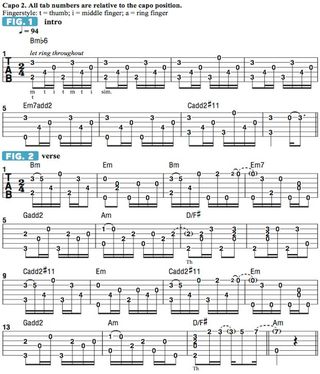Tommy Emmanuel Lesson: Composing Singable Melodies, and “It’s Never Too Late,” Part 1

As a composer, I strive to write melodies that have a special appeal and will “stick” in both my head and heart.
To me, a good melody tells a story and also is singable, even if it’s strictly instrumental. I find it helps to try and imagine that I’m writing for a vocalist; I still want to tell a story and take you somewhere by harnessing the power and beauty of music.
“It’s Never Too Late,” the title track to my latest album, is a song that was inspired by and written for my daughter Rachel, written even before she was born. I had an idea of what she would be like, and I tried to talk about that, musically speaking, and make it a soulful experience.
When I first played this song for some Polish friends of mine, who had a limited grasp of English, they described it as a “song that is in a minor key but sounds optimistic.” Most minor songs sound sad, but this one is full of optimism, and that’s my Rachel.
In playing “It’s Never Too late,” I employ what I consider to be my standard fingerpicking technique: the bottom three strings, which provide the low root notes and fifths of the chords that are played, are generally picked in an “alternating bass” fashion, with the thumb moving back and forth between two strings in a rhythm of steady eighth notes.
The upper parts of the chords and the melodic lines fall on the higher strings, and these notes are picked with the index and middle fingers, and occasionally the pinkie. An attention to pick-hand precision is essential, as there are two “lines,” rhythmically and harmonically, happening simultaneously.
The steady eighth-note rhythm of the thumb establishes the chords and basic rhythmic “grid” of the song and arrangement, while the melody is performed in a syncopated manner, with some notes falling squarely on the downbeats, in sync with the bass notes, and others falling in the spaces between the bass notes, on what are called the upbeats.
I perform “It’s Never Too Late” with a capo at the second fret. All tab numbers are relative to the capo position, so “0” means an open string, “1 means” one fret above the capo, “2” means two frets above, etc. I could just as easily play the song without a capo, but, to my ear, it sounds best in the higher key, as it gives the song a brighter feel. FIGURE 1 depicts the tune’s eight-bar intro, and for this section, I repeat the notes on the top four strings while the bass notes, sounded on the bottom two strings, move from B to C to E, resulting in a progression of Bm(b6) Cadd2(#11) Em7add2 Cadd2(#11).
When playing this passage, be sure to allow the open G notes to ring unobstructed. FIGURE 2 presents the tune’s 15-bar “verse,” which is essentially an eight-bar pattern played twice but with slight alterations the second time through: in bars 1–8, I bridge the gap between minor and major keys by first establishing E minor as the key center, but in bar 5 I introduce the relative major chord, G(add2). In the second half of the verse, beginning in bar 9, the initial Bm chord is replaced by Cadd2(#11) while the rest of the pattern is essentially repeated.
The section is only 15 bars long, as opposed to 16, because, instead of playing the final chord in the progression, D/F#, for two bars, as I had done in bars 7 and 8, I only play it for one bar before moving on to the tune’s chorus, which I’ll show you next month.
Emmanuel Dexterity April 2016 FIGURE 1
Emmanuel Dexterity April 2016 FIGURE 2

Get The Pick Newsletter
All the latest guitar news, interviews, lessons, reviews, deals and more, direct to your inbox!
Tommy Emmanuel is an Australian guitarist, who's worked as a session player and won awards for his solo recordings. He is one of the finest acoustic players working today. In 2019, MusicRadar named him as one of the 10 best acoustic guitarists in the world.




![Joe Bonamassa [left] wears a deep blue suit and polka-dotted shirt and plays his green refin Strat; the late Irish blues legend Rory Gallagher [right] screams and inflicts some punishment on his heavily worn number one Stratocaster.](https://cdn.mos.cms.futurecdn.net/cw28h7UBcTVfTLs7p7eiLe-840-80.jpg)







